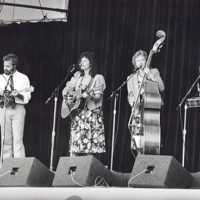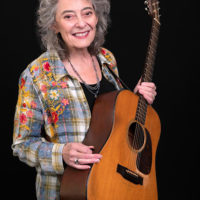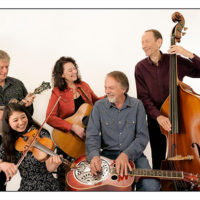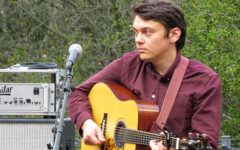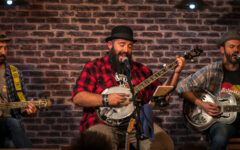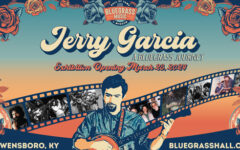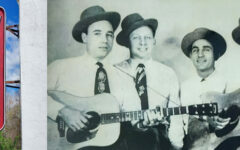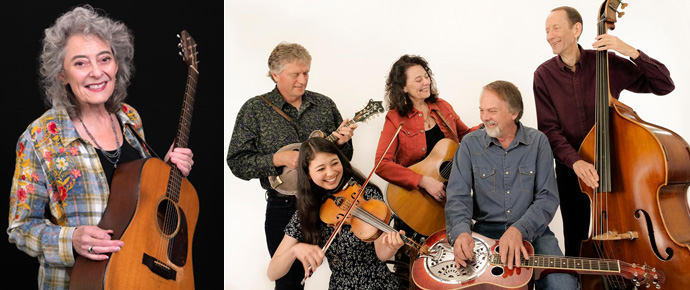
Photos of Kathy Kallick and The Kathy Kallick Band by Irene Young
Kathy Kallick has won a Grammy, two IBMA Awards, and is a recipient of a Lifetime Membership from the California Bluegrass Association. She co-founded the internationally acclaimed Good Ol’ Persons and has released twenty-two albums. She’s played with many of the country’s top roots musicians – including her own Kathy Kallick Band: Annie Staninec (fiddle), Greg Booth (dobro, banjo), Tom Bekeny (mandolin), and Cary Black (acoustic bass).
The Kathy Kallick Band will be headlining the Columbia Gorge Bluegrass Festival in Stevenson, Washington, July 23-24, 2021.
This is the first of a two part interview with Kathy.
Your Chicago folk roots are well documented. What things did you take away from that period?
My folks got caught up in the big Folk Boom in the Chicago area. They both loved the music and started playing guitar and learning songs. My dad had already been playing classical guitar and my mom was a wonderful pianist, so they had music knowledge and an understanding of chords and melody to some extent.
As a family we went to concerts and music parties, and my mom started performing and collecting songs from a variety of sources. When the Old Town School of Folk Music was formed my mom Dodi was one of the teachers and part of the community that grew around the music.
Was there any bluegrass in that folk scene?
Well, the music was less compartmentalized. So, there probably was some bluegrass, but I remember more dulcimers than banjos. There was a woman named Louise Heymann who moved with her family from Kentucky to Chicago, and came into the scene to be connected to the music she loved and had grown up with, and she was drawn to my mother’s singing. The two of them became very close friends, along with several other women who got together to sing, drink tea, make quilts, and learn songs.
There were several sources for the songs my mother loved, but I’ve come to understand that Louise taught her most of the songs that I loved and chose to take with me into my bluegrass repertoire.
When I released My Mother’s Voice, my tribute to my mom, I went to visit with Louise in Colorado. She was so happy to see the CD with all the pictures and to talk about the music. She pointed to the titles and said, “Oh, I taught your mother that song. Oh yes, we loved to sing that one. This one here, I learned this in church and taught it to your mom.” So in a way that album was a tribute to Louise Heymann as well as my mom. I just didn’t know that at the time!
My Mother’s Voice on Spotify
That sounds amazing. Were there any ‘aha’ moments from that period?
My mom taught me some songs and guitar stuff, things like All The Good Times Are Past And Gone, The Wreck Of The Old Number 9, and other folk songs. Being a teenager in the sixties I loved the Beatles, Joni Mitchell, James Taylor, and all the bands of my era. I’d get together with friends and we’d try and figure out how to play the songs we liked. But it was the night I saw John Prine at a Christmas concert at the Old Town School that changed my course. One of my ‘aha’ moments. John’s older brother David is a dobro player, and he’d been to music parties at our house and played a bit with my mom sometimes. He brought his younger brother to perform a few of the songs he’d been writing, and that was the beginning of John’s career. I was so gobsmacked by these beautiful, moving, very simple songs that each told a story. I thought, that’s the kind of songs I want to make up. It took me a while to get there!
What instruments did you start with?
I started out learning to play the piano when I was nine years old, and it’s a good first instrument. Everything is laid out in such a clear and visual way, so linear. I wasn’t all that interested in learning to read music, preferring to pick out the pieces by ear, which infuriated my piano teacher. The thing that she hated even more was my impulse to make up my own songs. After about five years I switched to guitar as my chosen instrument.
Tell us about your westward migration?
After I’d started performing a bit in Chicago, trying to be a solo folk singer like my mom, and playing some of my own songs, I spent a year in Iowa. I was there with my boyfriend who was learning to play old-time fiddle from a wonderful man named Pearl Sivetts. While he learned to play fiddle tunes, I started learning to play rhythm guitar with a flatpick so I could accompany them at fiddle contests. After that year we moved to San Francisco so I could go to the Art Institute and study painting.
Interesting. Your timing couldn’t have been better.
We’d heard about this venue called Paul’s Saloon and the nightly bluegrass, and started going to see the Phantom’s Of The Opry. I fell in love with Pat Enright’s singing and Gene Tortora’s dobro playing, and the whole scene at that bar. Once I turned twenty-one and could finally get in there, I became a regular. A fan.
I met Laurie Lewis and Paul Shelasky and all the others who would form the band the Good Ol’ Persons. I asked Pat Enright to teach me some songs, and he gave me Sweet Dreams, Dark as the Night, and a few others. I loved his combination of country and bluegrass with his bluesy singing. I still do!
So how did the Good Ol’ Persons come about?
I’d never been in any kind of band, and when Laurie, Josie Mendelsohn, Dorothy Baxter, and Sue Shelasky invited me to get together for fun and sing some bluegrass, I was excited but very new and inexperienced. The story is well known around here—the night we went into the jam at Paul’s and played three songs only to be asked to take over Sunday nights the next week. We accepted but said we needed a month to learn enough songs. I was drafted to play bass, as Dorothy was an excellent lead guitar player. So, I had a crash course in singing bluegrass harmonies and playing the upright bass, and we learned forty songs as quickly as we could!
How did the name Good Ol’ Persons come about?
After about a hundred ideas we settled on Josie’s suggestion of the Good Ol’ Persons, riffing on the phrase Good Ol’ Boys, and referencing the current trend in renaming things like “chairman” as “chairperson.” The plain acknowledgement of the fact that we were all women.
The original all-female lineup was fairly revolutionary and certainly ahead of its time. Were crowds mostly supportive?
The “all girl band” was a novelty, which had its pros and cons. We were wildly popular fairly quickly, but of course we were subjected to constant sexist remarks and comments, especially from MC’s and the audience. The male musicians in the Bay Area were for the most part extremely supportive and helpful, welcoming and warm, and generous. And sometimes we were championed by women as role models for breaking the bluegrass male-dominated glass ceiling.
Absolutely. And thank you for opening some of those doors.
Well, the thing about an “all girl band” is, does it really break the stereotype? It’s a novelty act, even if it’s an excellent novelty act, but the radical thing seemed to us to be the coexisting of men and women in the same band, as equals, with no hierarchy.
There have been promoters over the years who’ve been uncomfortable paying a woman, or have tried to take advantage and not pay me what we’d agreed upon, or do something weird. But for the most part, it’s been just fine. The music world, the bluegrass world, has come a long way from that time. The gender issues are different now with Bluegrass Pride, and issues of BIPOC people being included have entered the conversation. It’s lovely to witness.
Tell us about the music from the original Good Ol’ Persons lineup.
At that time Josie played clawhammer banjo. We played a variety of styles including old-time, country, Irish and Celtic music, and pretty soon we added my first attempts at writing bluegrass songs. There were those who quibbled and said we weren’t really bluegrass, but we played what we liked, and mostly we were having a blast! We all loved to sing and try finding the harmony parts, and we had four sets a night to try out all the styles we were learning. We all tried singing all the parts, but I really struggled with that baritone part. I still do! I remember trying to play bass in Bb while singing baritone on Once More, a new song for me. I wound up singing the same notes I played on the bass. All I could manage to do.
How did the band change from this early days?
After six months Sue Shelasky left the area and we needed a mandolin player. Her little brother Paul was the obvious answer. Just like that we were no longer an “all girl band,” though Paul did wear a skirt the first night.
We continued in that mixed gender format for the next twenty years, and most of the bands I’ve played with for the entire forty plus years have been co-ed. I like that. It feels like a family and like a nice balance of energy.
What was it like touring? I’m imagining a fairly crowded van.
By the 1980s we’d started traveling and recording and began to have a more nationally known presence. The Good Ol’ Persons band with Sally Van Meter, John Reischman, Bethany Raine, Paul Shelasky, and then Kevin Wimmer made three records for Kaleidoscope Records, a label formed to present the David Grisman Quintet. We were lucky to be part of that prestigious Bay Area roster, and the records enabled us to be heard away from our hometown and start to gain a reputation. Our first tours were up and down the West Coast, but early on we were invited to play Bill Monroe’s Bean Blossom Festival.
THIS WAS A BIG DEAL! We arranged to borrow a big station wagon from a fan, somehow squished all five of us, the instruments and suitcases into the thing, and drove from Berkeley to Indiana, playing small concerts and festivals along the way. We had some flat tires, including one spectacular blowout with me at the wheel. The car careened across several lanes of traffic speeding towards a limestone wall at the side of the highway. The shoulder was made up of several feet of deep, wet mud that sucked the tires down into the ground, with the car stopping inches from the rocks.
This made us late for our spot at Bill Monroe’s Fanfest in Nashville. But, when we got there and told him the story, he said, “Well, that mud was all that saved you. That was some powerful mud.” Then he gave us fifty dollars to get new tires.
I guess that could have gone either way, but he obviously liked you.
This was the first of two times we played that festival, and we were well received, but honestly, some folks didn’t know what to make of us. None of us were siblings and nobody was married to anybody else in the band. It wasn’t any kind of family band or anything that made sense to people who’d only seen women in bands in those contexts. They just had to see and hear us and accept that we were doing something a bit unprecedented at the time. We were in the company of Wilma Lee and Stoney Cooper and the Lewis Family, but we weren’t like that.
As that decade went along, we got to play many festivals with Hot Rize, the Johnson Mountain Boys, the Tony Rice bands, and the Nashville Bluegrass Band with my first favorite singer, Pat Enright. Then along came Lynn Morris, and of course Laurie Lewis was fronting her own band, and the world started to include more groups that looked like us. No family members or married couples, just five people who loved to play music together.
What were you playing?
While we loved to sink our teeth into a classic Bill Monroe song, the repertoire of this band was always full of numbers that were outside of traditional bluegrass: swing, Latin, Irish, Cajun, or whatever the band members were into and excited by. There were a lot of instrumental ensemble parts that referenced other styles, sometimes pop-influenced backup vocals, and all those original songs. This made us stand out from the other bands in those days, though it’s become more common place now, for sure.
All the way through the ’80s the Good Ol’ Persons drew curious folks who kept asking us things like, “but, how do you women get into a jam session?” This puzzled us because we’d had the experience of being included all along. The West Coast men were so supportive and they liked playing and singing with us. Especially as we got better at our craft.
There was a radio interview where the DJ asked us, “So, what’s it like being in a band with two men and three girls?” To which Bethany answered, “Well, we like to think of it as three women and two boys.” Which made the DJ laugh but kind of insulted the guys. We apologized a bunch on the car ride afterwards. People said and did weird, funny, peculiar things, but for the most part audiences loved the band. We had wonderful experiences all across the country, in Canada, and all over Europe. It’s been a thrill to see younger musicians covering some of our songs from those recordings.
Did you ever see or play with the all-female band Buffalo Gals out of Syracuse?
The Buffalo Gals were, I believe, simultaneous with the Good Ol’ Persons. They played a night at Paul’s Saloon, and I definitely went to see them! We later formed a band with Nancy Josephson when she moved to Marin in the late ’70s. That band also had Gene Tortora and Keith Little. It was called Old Friends and it carried on for several years with changing personnel.
Were there other West Coast bands on the bluegrass circuit back east then?
In the ’80s when the Good Ol’ Persons were touring so much, we did bump into other bands from California. David Grisman was often the headliner on a festival lineup with us. We also shared festival stages with the Grant Street String Band, High Country (especially if it was a traditional bluegrass festival), the Blue Flame String Band (if it was a folkier festival), and Berline, Crary & Hickman.
It was often the case that we would be the only band with women; there was a commonly held feeling that an event could only have one band with women—as we all sounded the same. Or too similar. For this reason we rarely got to share the stage with Claire Lynch, Skyline with Dede Wyland, or even Laurie.
Pete Wernick was a true champion of women musicians, and he convinced some festivals to have more than one band led by a woman. So we got to play with the Sally Mountain Show, which was Rhonda Vincent’s family’s band. Pete introduced us to Lynn Morris at a festival in Colorado in 1988 as she was just starting to put together her own band.
Life’s Too Short For Me To Worry Over You – The Good Ol’ Persons Reunion 2015
To be continued…
Copy editing by Jeanie Poling.

